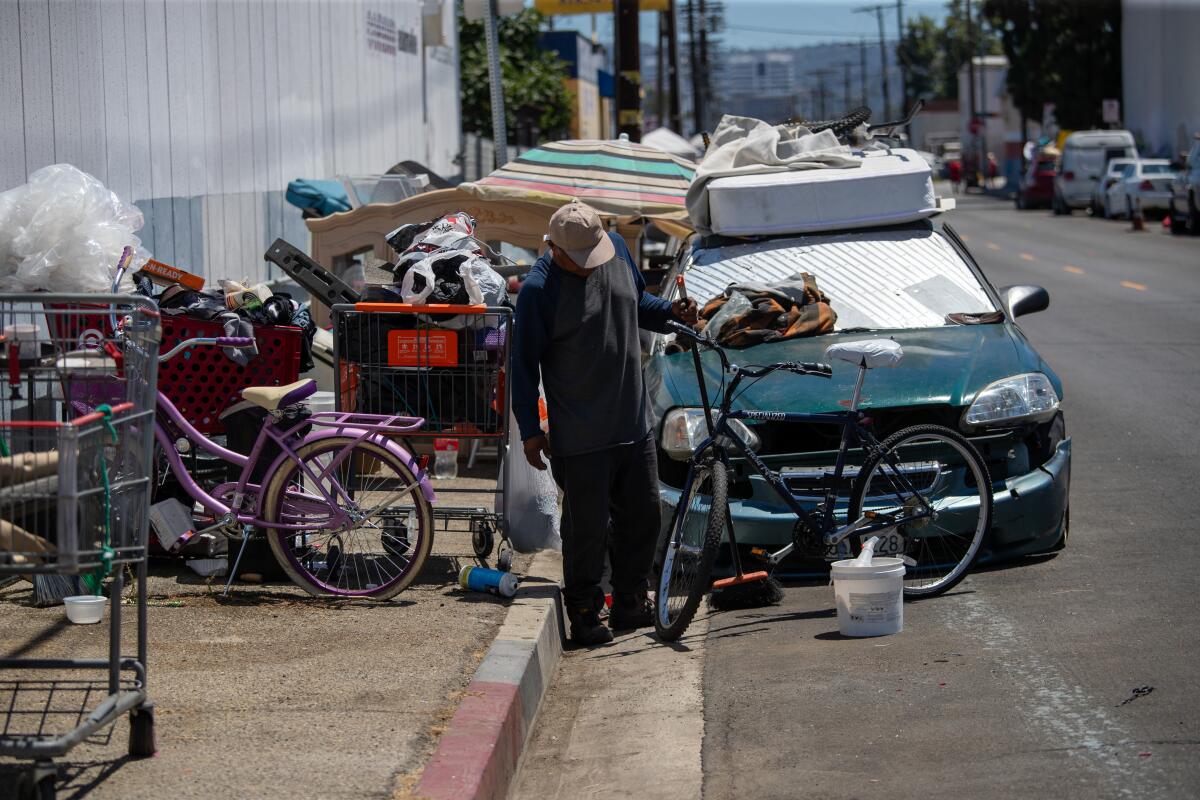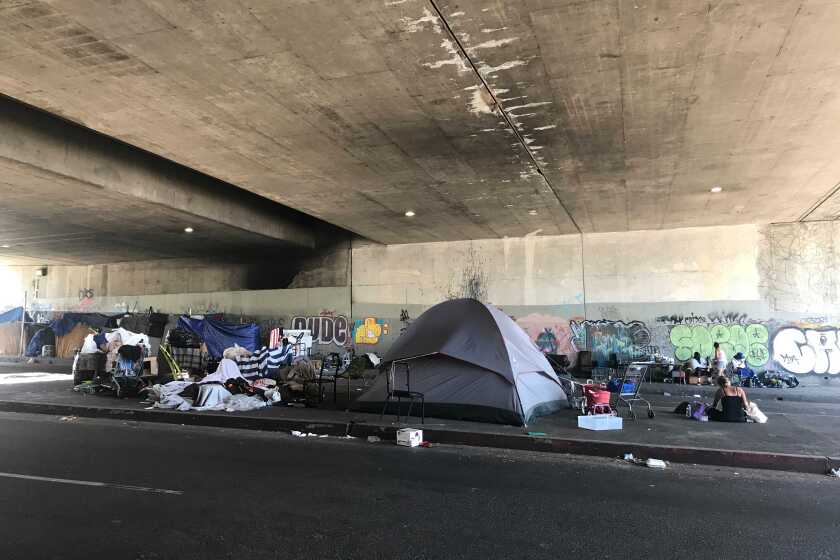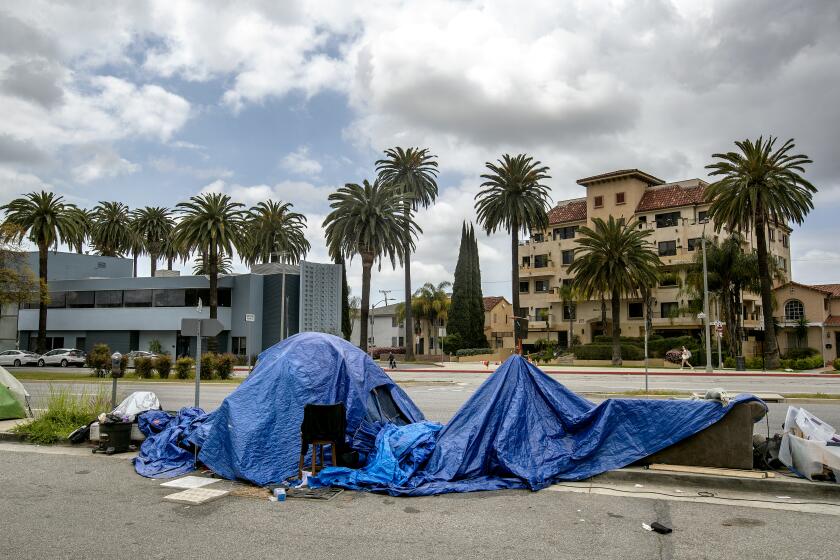Opinion: People think drug use causes homelessness. It’s usually the other way around

- Share via
A common perception among many Californians is that substance abuse is a chief cause of people losing their housing and living on the streets. But research debunks this myth.
Findings from the recent California Statewide Study of People Experiencing Homelessness encompassing more than 3,200 adults — the largest and most representative sample of homeless individuals since the 1990s — found that 50% have not used any drugs (methamphetamine, cocaine, crack cocaine or nonprescription opioids) in the last six months.
While drug use is much lower in California’s housed population, by no means does every person who is homeless actively use drugs.
Andromeda, Erica and Heidi have gotten by for years on the street. Sometimes government helps them, but at other times it makes their lives harder.
For those who did use drugs in the last six months, 40% of people started using — more than 3 times a week —after becoming homeless. Thirty-one percent of those individuals reported using methamphetamine and 11% used nonprescription opioids more than three times per week. Those who spent most of their nights unsheltered in a non-vehicle (sleeping outside, in tents, in places not meant for human habitation) and individuals who were homeless for more than a year had higher proportions of methamphetamine and opioid use.
The California Statewide Study also conducted interviews with more than 300 homeless adults, exploring their daily life, including drug use. That work, along with other research, finds that individuals frequently use methamphetamine to help them stay awake at night to protect themselves and their property from assault and theft.
People also report using drugs to cope with depression, anxiety and the trauma of being homeless.
Getting people off the streets and into temporary shelter isn’t the only answer to L.A.’s homelessness problem. We need more permanent housing solutions.
Drug use is correlated with the length of time someone is homeless and the extremity of their living conditions. In my research and volunteer work with agencies focused on homelessness, I have seen how drug use in the unhoused population is highly criminalized and stigmatized. By gaining a more accurate picture of drug use among unhoused people, policymakers and community groups can provide better harm-reduction and treatment services, and housing resources to those struggling to get by.
Most shelters and housing initiatives require people to practice drug abstinence before they can qualify for these programs. This policy is not feasible for many, and those who achieve abstinence may fall back into drug use if they remain homeless and are not able to find stable housing.
An opinion from the 9th Circuit favors prosecuting people for sleeping outside. Punishment is not the path forward.
Other literature on social determinants of health also link housing as a primary factor for avoiding drug use. Programs that emphasize “housing first” models, or providing housing regardless of one’s drug use, have shown that even those who use drugs have good retention in maintaining their housing once they are stably and safely housed.
Houston offers a prime example of successfully applying housing first to move more than 25,000 people experiencing homelessness into their own housing units over the last decade. Together with county agencies, services providers, nonprofits and corporations, Houston prioritized housing without requiring individuals to be abstinent from drug use or in a treatment program. Nearly all individuals have been able to retain their housing after two years.
Last year, 171,000 people were experiencing homelessness in California. Recently, Gov. Gavin Newsom approved $3.5 billion in California’s budget to end and prevent homelessness, aiming to move more than 2,600 individuals into housing.
Jermaine, Jason and John all landed on the streets when they were squeezed between high housing costs and low incomes. What could have kept them in their homes?
But many Californians will still remain unhoused. The best way to service this population is to move away from criminalizing and stigmatizing drug use. Recently, the San Francisco Police Department arrested 450 individuals who used drugs and who were intoxicated in public. However, this furthers disparities and injustice toward people experiencing homelessness, drives people away from accessing proper resources, maintains the barriers that keep people homeless and increases their risk of drug-related overdose.
Instead, state and local governments should invest in harm-reduction programs, such as needle exchange programs, overdose prevention centers and overdose-reversal medications. These strategies can save lives, reduce infectious diseases (HIV/hepatitis C), reduce use of emergency care, reduce overdose deaths and connect people to services even while they remain unhoused.
Regardless of an individual’s drug use, policymakers and advocates should prioritize getting people experiencing homelessness into safe, secure and stable housing. Only then could we start to manage and treat drug use for unhoused people effectively and appropriately given their individual needs.
Ryan D. Assaf is a postdoctoral fellow with the Benioff Homelessness and Housing Initiative at UC San Francisco and a public voices fellow through the OpEd Project. @RyanDAssaf
More to Read
A cure for the common opinion
Get thought-provoking perspectives with our weekly newsletter.
You may occasionally receive promotional content from the Los Angeles Times.














